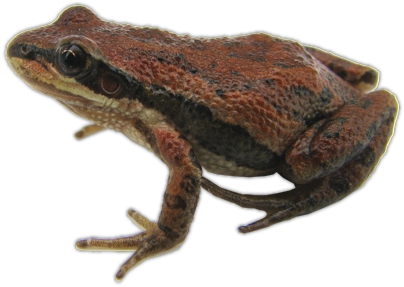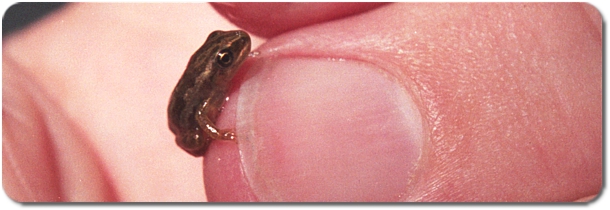Boreal Chorus Frog

What it looks like
The Boreal Chorus Frog is a tiny treefrog. An adult is only about 2 cm long. They are brown or green with dark stripes or patches. They can change their colour, from green to brown or make their colours lighter or darker.
Look-alikes
Boreal Chorus Frogs look a lot like Spring Peepers, but Spring Peepers always have an "X" mark on the back and Boreal Chorus Frogs do not. A small Wood Frog froglet could look like a Boreal Chorus Frog, too, but it will have a dark triangle behind its eye.
Name
The word "boreal" means northern. A "chorus" is a group of singers, or croakers in the case of the treefrogs. These treefrogs get together in large groups to call for mates in the spring. So they are the "northern group-singing frog"!
Scientific Name
The Boreal Chorus Frog's scientific name is Pseudacris maculata. Learn what that means on this page: Scientific Names.
Where it lives
The Boreal Chorus Frog is found mainly in forests, but lives in grasslands, marshes and even in cities. This frog lives in most of central North America. It is found in all parts of Manitoba, except the far north. And that may just be because no one has seen them there, yet.
Where Boreal Chorus Frogs live in North America.
Habits
The Boreal Chorus Frog is a kind of treefrog. It can climb, but usually lives on the ground. They hunt for food on the ground. In summer they hunt mainly at night and rest under leaves or in thick grass in the day. Boreal Chorus Frogs spend winter under the leaves or logs on the forest floor or in thick grass and can freeze solid.
Food Web
Adult Boreal Chorus Frogs eat small invertebrates, like mosquitoes, flies and beetles, and small spiders and centipedes.
They are eaten by snakes, birds, small mammals like mice and shrews, and by large insects. The tadpoles are eaten by birds and aquatic insects.
Life Cycle
Boreal Chorus Frogs mate very early in spring. Sometimes they can lay eggs by early April. Usually they breed from mid-April into May. They breed in small ponds filled by melting snow or small permanent ponds.
| Hear the Boreal Chorus Frog mating call: |
Each female lays as many as 200 eggs in small clumps on plants or sticks under the water. The eggs hatch in about 3 days. The tadpoles grow for about 40 days before they become treefroglets by June or early July. The new treefroglets are tiny, only about 1 cm long.

And you thought adult Boreal Chorus Frogs are small,
here's one just changed from a tadpole!
Numbers
The Boreal Chorus Frog may be the most common amphibian in Manitoba, but they are so small and hide so well that we have no idea how many there are. There may be hundreds of them in every hectare of forest.
Special Things
The Boreal Chorus Frog is Manitoba's smallest amphibian and probably our most common amphibian.
In winter they sleep under leaves or logs in forests, or under thick grass in meadows. Their bodies can freeze solid! Then in spring they warm up and hop away. Boreal Chorus Frogs can live just about anywhere, as long as there are small ponds to lay their eggs in.
How to Find Boreal Chorus Frogs
Listen for males calling from mid-April to early June, but keep your ears peeled later in the season, too. Heavy rains can make the males call until mid-summer. Evening is the best time to hear them, but they will call during the day, too. Even if you hear them they are tiny and hard to see in ponds or nearby grass or leaves.
Use by People
Boreal Chorus Frogs probably aren't used by people. Most people have never seen one in the wild, but have probably heard the call of the males. People like to listen to the "chorus" of these frogs. It's a sound that means spring is here!
| Next: Blue-spotted Salamander | Back to: Amphibians and Reptiles Front Page |
